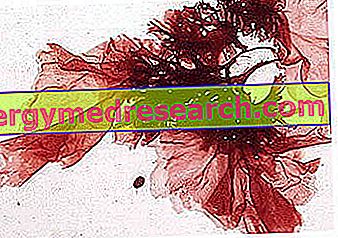Red algae: definition
Known in botany as Rodoficee or Rhodophyta, red algae are eukaryotic organisms devoid of flagella: most of the red algae has marine origin and prefers warm seas, although some freshwater species have been identified.
The term Rhodophyta comes from the Greek: the root rhódon (ῥόδον) means "pink", while the ending phytón (phytón) "plant". These algae have reddish hues due to the presence of particular red pigments, known as phycoerythrin, mixed with bluish pigments ( phycocyanins ): the combination of these colors, together with chlorophyll, generates typically red algae or, in other cases, purplish, distinguished by the their particular elegance both in color and shape.

Botanical description
Most red algae belong to the Floridee class; among the most important genres are Gelidium and Chondrus.
Thanks to the presence of symbiotic cyano-bacteria, red algae contain a high amount of chlorophyll type a and d .
The red algae consist of a vegetable body, known as a thallus, particularly elaborate, consisting of the union of cellular cords: the thallus differs into cauloids, rhizoids and filloids. Still, it is good to distinguish two types of thallus of red algae: the branched thallus tends to cover the entire main body, so that the red alga takes on a very particular cauline appearance. We speak, instead, of laminar red algae when the filaments of the thallus grow in a unidirectional way and on the same plane.
Red algae consist mainly of cellulose and have photo-synthesizing properties; however, there is no lack of cellulose-free red algae: in these varieties, cellulose is replaced by other types of polysaccharides, such as mannans and xylans. In general, the cellular wall of red algae is the source of other polysaccharides (agar agar) and carrageenan (hydrocolloid used in the pharmacological, industrial and food sectors, such as gelatine or thickener).
Red algae are rich in sulfur compounds, accumulated in intercellular spaces or in the cell wall; the quantity of sulfuric esters is very variable from species to species (0-35%).
Loans
The species Palmaria palmata and Porphyra, widespread in the British Archipelago, are red algae used as food for human consumption. In particular, the Palmaria palmata is of a purple-red color and is distinguished by its particular and spicy taste: in this regard, this red alga is used for the preparation of tasty soups and soups, and to enrich seasonings.
The use of red algae and algae in general is particularly common in the East; intensely cultivated, red algae are considered a gastronomic delicacy.
The use of red algae in cosmetics has been known since ancient times. As we have seen, red algae grow mainly in marine environments: precisely for this reason, algae absorb the innumerable active products that the sea offers, and careful man exploits the properties of algae for beneficial purposes for beauty and above all for body health. The "cure" with algae is also known in thalassotherapy, the therapy based on the curative action of the sea, the marine climate and its products (algae, in this case).
In cosmetics, algae are used to counteract the formation of free radicals, the main causes of skin aging. Furthermore, the preciousness in minerals (magnesium, potassium, calcium) is used in cosmetics to revitalize cells.
Red algae are also widely used as adjuvants in the treatment of cellulite and obesity: in any case, the action of algae is maximized when combined with a balanced diet, accompanied by sports.
It seems that algae have a hypothetical anti-stress power, potentially rebalancing the CNS (hypothesis not fully demonstrated).
Useful in the treatment of eczema and psoriasis: it seems, in fact, that red algae are able to regulate the production of keratin (topical and / or oral use).
From the processing of red algae, one can obtain a gelatinous substance, carrageenan, whose use is widely used in the food, industrial and cosmetic sectors. The algae gelatinous extract is used as a thickener, emulsifier, gelling agent and stabilizer. Considering that carrageenan promotes the feeling of satiety, this substance is widely used in the formulation of supplements, useful as adjuvants to low-calorie diets. Carrageenan is also used as a mass laxative.
Furthermore, from the processing of red algae, agar agar can be obtained, used as a culture medium for petri dishes.
In the industrial sector, the products obtained from the processing of red algae are used as a car polish and in paints.
Summary
Red algae: in short
| Red algae: general description | Multicellular eukaryotic organisms (most of them), without flagella. 4, 000 different species of red algae have been identified |
| Red algae: etymology of the term | The term Rhodophyta derives from the Greek: the root rhódon (ῥόδον) means "pink", while the ending phytón (phytón) "plant" |
| Red algae: botanical description | Botanical name : Rodoficee or Rhodophyta Class: Floridee Most important genres: Gelidium and Chondrus Chlorophyll : high amount of chlorophyll aed Thallus (vegetable body): branched or laminar, it differs in cauloids, rhizoids and filloids Polysaccharides : cellulose, mannans, xylans, agar agar, carrageenan Other components : sulfur compounds (eg sulfuric esters) |
| Red algae: Palmaria palmata and Porphyra | Red algae used as food for human nutrition Taste, particular and spicy → preparation of tasty soups and soups, and to enrich seasonings |
| Red algae: food sector | Consider a gastronomic delicacy in the East |
| Red algae: cosmetics and phytotherapy | Man exploits the properties of algae for beneficial purposes for beauty and above all for the health of the body → thalassotherapy
|
| Red algae: carrigenina |
|
| Red algae: other uses | Agar agar extraction from red algae → culture medium for petri dishes Products obtained from the processing of red algae → used as car polish and in paints |



